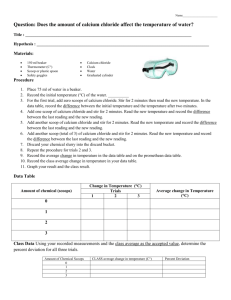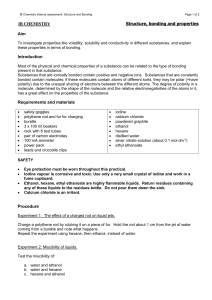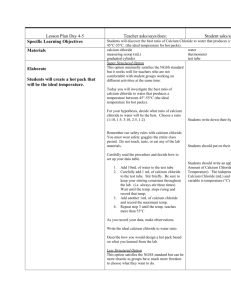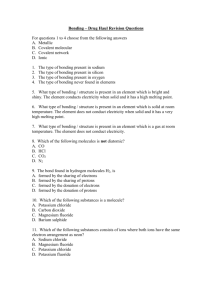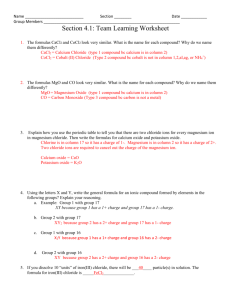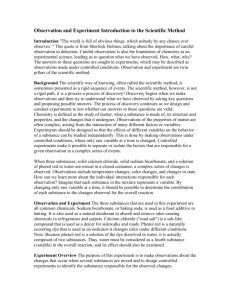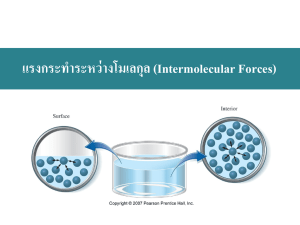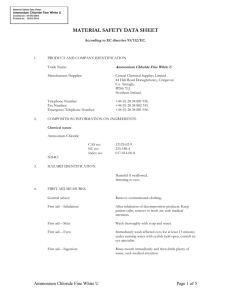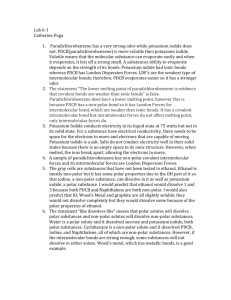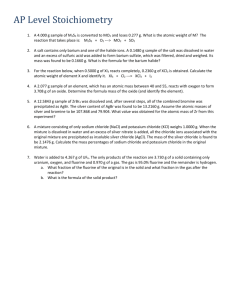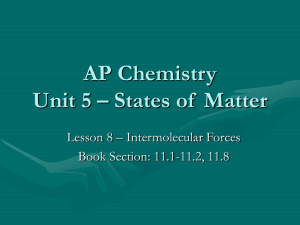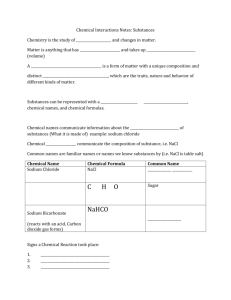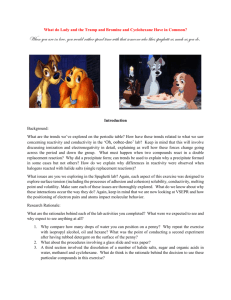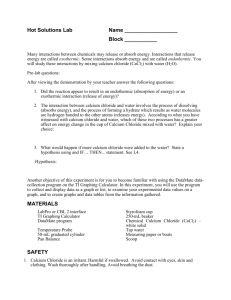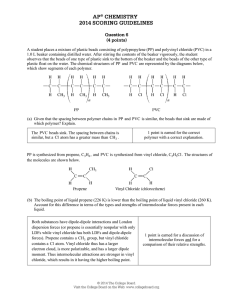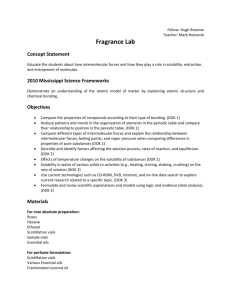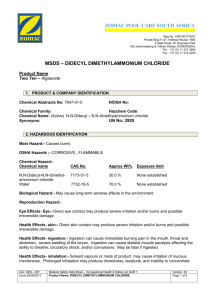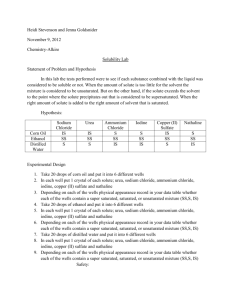Properties of Solution Logs
advertisement
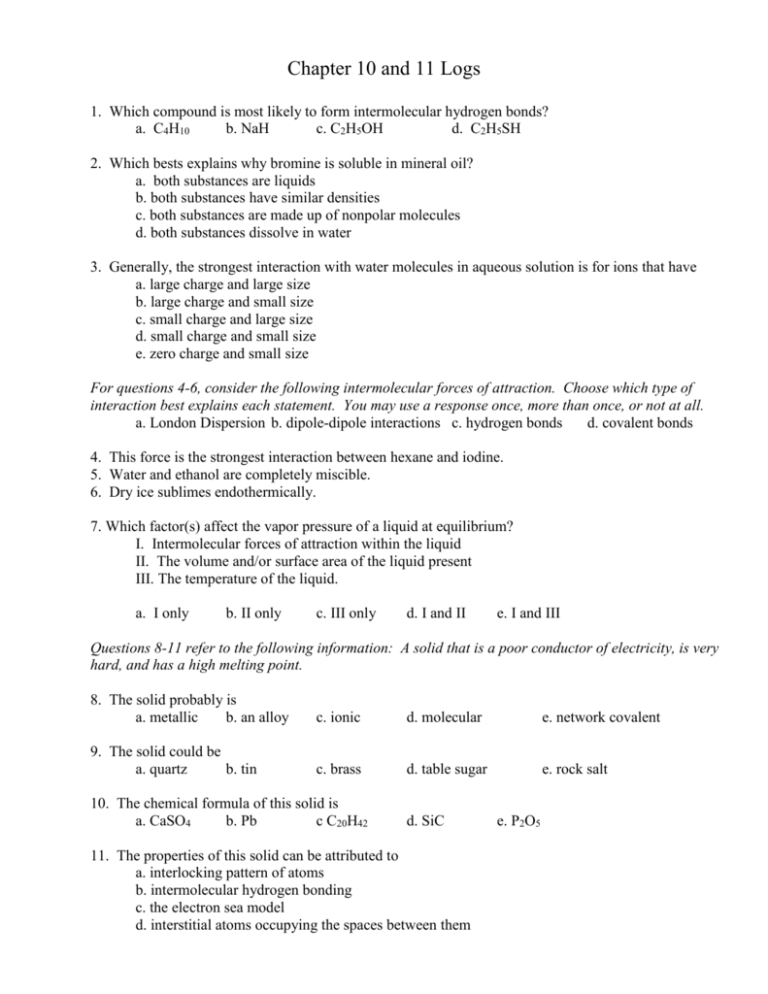
Chapter 10 and 11 Logs 1. Which compound is most likely to form intermolecular hydrogen bonds? a. C4H10 b. NaH c. C2H5OH d. C2H5SH 2. Which bests explains why bromine is soluble in mineral oil? a. both substances are liquids b. both substances have similar densities c. both substances are made up of nonpolar molecules d. both substances dissolve in water 3. Generally, the strongest interaction with water molecules in aqueous solution is for ions that have a. large charge and large size b. large charge and small size c. small charge and large size d. small charge and small size e. zero charge and small size For questions 4-6, consider the following intermolecular forces of attraction. Choose which type of interaction best explains each statement. You may use a response once, more than once, or not at all. a. London Dispersion b. dipole-dipole interactions c. hydrogen bonds d. covalent bonds 4. This force is the strongest interaction between hexane and iodine. 5. Water and ethanol are completely miscible. 6. Dry ice sublimes endothermically. 7. Which factor(s) affect the vapor pressure of a liquid at equilibrium? I. Intermolecular forces of attraction within the liquid II. The volume and/or surface area of the liquid present III. The temperature of the liquid. a. I only b. II only c. III only d. I and II e. I and III Questions 8-11 refer to the following information: A solid that is a poor conductor of electricity, is very hard, and has a high melting point. 8. The solid probably is a. metallic b. an alloy c. ionic d. molecular e. network covalent 9. The solid could be a. quartz b. tin c. brass d. table sugar e. rock salt 10. The chemical formula of this solid is a. CaSO4 b. Pb c C20H42 d. SiC 11. The properties of this solid can be attributed to a. interlocking pattern of atoms b. intermolecular hydrogen bonding c. the electron sea model d. interstitial atoms occupying the spaces between them e. P2O5 12. The aqueous solution of which salt will have the strongest cation-dipole interaction? a. NaCl b. MgCl2 c. K2SO4 d. Cr(NO3)3 e. CaSO4 13. Enough water is added to 11.5 g of ethanol to make 2.00 L of solution. What is the molarity of the ethanol? a. 0.125 M b. 0.250 M c. 0.500 M d. 5.75 M e. 0.333 M 14. Which pair of substances will dissolve in each other? I. CH3OH II. C6H6 a. I and II b. II and III c. I and III 15. All the following will dissolve in water except: a. ethanol b. aluminum chloride III. CH3CH3 d. I and II, II and III c. calcium nitrate d. hexane Problem Solving 1. Use concepts of chemical bonding and/or intermolecular forces to account for each of the following observations. List the type of intermolecular force for each substance. a. The boiling points of water, ammonia, and methane are 100oC, -33oC, and -134oC, respectively. b. At STP, chlorine is a gas, bromine is a liquid, and iodine is a solid. 2. Solid Ammonium chloride dissolves in water with a marked decrease in temperature. Calcium chloride dissolves in water with a marked increase in temperature. Little or no temperature change is observed when solid sodium chloride dissolves in water. a. Write an equation that describes the dissolving process of ammonium chloride. b. Is the dissolving of calcium chloride endothermic or exothermic? c. Describe the opposing forces of attraction that are at work in the dissolution of calcium chloride. Which are greater? Why? 3. Using some common laboratory equipment and materials, devise a plan to deduce the type of bonding in a sample of unknown solid. Specify the tests you would perform and discuss what the results mean.

